Topic: Healthcare
Truth is good for health
Its patients are ‘literally a captive market.’ Is this California health care giant failing them?
11 highest-paid healthcare CEOs: Their paths to the top
Out of the Blues
Haas alumni work to destigmatize mental illness and improve well-being.
In the fall of 2020, deep into the pandemic, Newton Cheng, MBA 08, was working harder than ever. By early 2021, he knew something was wrong. He was spent, exhausted, unable to feel happiness or joy. One morning upon waking he was filled with so much dread that he couldn’t get out of bed.
As the director of health and performance at Google, Cheng oversees programs that promote well-being in Google’s global workforce. But despite his job description and an appreciation of the importance of physical and mental health, he wasn’t immune to his own mental health challenges. So in January 2022, he opted to take a three-month leave to address his depression and anxiety. “My therapist called it ‘overwork syndrome,’” Cheng says. It was affecting all aspects of his life, including his most important relationships. “I was ashamed of the way I was showing up as a husband and father.”
Time away gave him the space to recalibrate, yet he knew his situation was hardly unique. According to Microsoft, over 50% of us globally are burned out at work. Another survey by McKinsey says that 59% of the global workforce reports having at least one mental health challenge.
After returning from leave, Cheng decided to publicly share his story. Doing so didn’t come naturally to him, but he put aside his discomfort and posted about his experience on social media. He got positive responses on Facebook and Instagram, but by far the largest response was within his professional network on LinkedIn. “The post received roughly 2,000% more engagement than my previous posts,” he says.
Indeed, if the COVID-19 pandemic has any silver lining, it may be the way it’s revealed some of society’s long-simmering ills, one of which is the state of our mental health. Long a taboo subject in general—and in the workplace in particular—the trauma and disruption of the pandemic brought mental health out of the shadows and positioned it front and center.
Fortunately, members of the Haas community have long recognized problems in the way we talk about mental health and in the systems we use to provide care. And they’ve put their energy into trying to solve them.
Changing the culture
Ian Shea, BCEMBA 07, learned firsthand how important it is to tend to one’s own mental health when a company he started didn’t pan out. The experience was emotionally taxing, and he was dogged by fear, anxiety, and doubt. “To get through that, just for my own personal survival, I really had to develop my own emotional and spiritual practice,” he says. But like Cheng, Shea knew his experience wasn’t unique and that others had gone through similar trials—or would at some point. He realized that creating space at work for more emotional support and open dialogue would be a good thing for people and for businesses. But they needed guidance.
So Shea created I M Human to provide that guidance to companies that have decided to make well-being a strategic priority. This is more than simply implementing a program, he says. “It’s a practice. Culture is at the heart of it. It’s how leaders treat their employees, how they give feedback, and how they create space for self-care.” The goal is broad culture change within companies, so well-being becomes a core part of their values.
Shea’s company was brought in by global law firm O’Melveny & Myers after the American Bar Association reported high rates of depression, anxiety, and loneliness in the legal profession and created the ABA Well-being Pledge. The firm, says Shea, has since been awarded the #1 well-being program in the legal industry, in part because of its work with I M Human.
A challenge to find new ideas
 According to Gallop’s 2022 State of the Global Work Force, a mere 21% of employees said they were engaged at work, and just 33% said they were thriving in their overall well-being. While no field has a monopoly on unhappiness, Michael Martin, MBA 09, discovered that construction workers have one of the highest suicide rates across all industries. Martin works in energy, infrastructure, and sustainability at Google, and he regularly visits construction sites, so the issue was more than academic.
According to Gallop’s 2022 State of the Global Work Force, a mere 21% of employees said they were engaged at work, and just 33% said they were thriving in their overall well-being. While no field has a monopoly on unhappiness, Michael Martin, MBA 09, discovered that construction workers have one of the highest suicide rates across all industries. Martin works in energy, infrastructure, and sustainability at Google, and he regularly visits construction sites, so the issue was more than academic.
He shared what he’d learned with senior leaders at Google. “Clearly,” says Martin, “if we’re dealing with these issues on site, this was going to result in project delays and money lost. But beyond that, there’s a moral imperative to make the sites a better place to work.”
By way of a solution, in 2020 Martin founded the John E. Martin Mental Healthcare Challenge at Haas, seeded with his own money and sponsored by Google. The annual case competition aims to develop solutions to improve the quality of mental healthcare and access. In its inaugural year, 12 teams from top MBA programs proposed ways to use data to better support construction workers facing anxiety, addiction, depression, and suicide. The winning solution—from a Berkeley Haas team—featured an AI-powered app that addressed prevention, assessment, and intervention.
Martin had already made a commitment to improving mental health via his Berkeley connections. In 2015 he founded the John E. Martin Fellowship in honor of his father, a Vietnam veteran who overcame his own mental health struggles and became a counselor to fellow vets. The Martin Fellowship provides financial support to students at Haas, the School of Public Health, and/or the School of Social Welfare. The Healthcare Challenge further elevates the importance of addressing mental health for all members of society.
Julia Cohen, MBA/MPH 24, was a member of the prize-winning team at the 2022 Mental Healthcare Challenge, when the focus was adolescent health. Cohen and her teammates developed an intervention designed for rural transgender youth called Y’ALL. Says Cohen, “Y’ALL seeks to build community and foster resilience through both digital technology and a rotating in-person neighborhood pop-up event.”
According to Microsoft, over 50% of us globally are burned out at work. Another survey by McKinsey says that 59% of the global workforce reports having at least one mental health challenge.
Cohen’s team focused on transgender rural adolescents because the unmet need in that population is so great. “Rural trans youth have higher mental health incidents. Suicidal ideations are higher, and access to mental health resources is limited,” Cohen says. Y’ALL’s emphasis is on building community, with a focus on preventing mental health issues rather than waiting until serious problems take root.
 Reaching young people
Reaching young people
Transgender rural youth face unique challenges, but the incidence of anxiety and depression among all young people has been on the rise. Rates were increasing well before the pandemic, but COVID’s disruptions and enforced isolation only made things worse.
Addressing mental health issues as early as possible is key, says Anjali Menon, BS 11. “The majority of mental illness begins by age 24 or before. So you really have to start early,” she says. In 2021, Menon co-founded tbh, a resource that partners with schools—both K-12 and higher ed—to supplement the mental health services available to students. Menon was motivated to start tbh when she saw the inadequate options available to a college-age friend who was struggling with mental health issues.
“I’m trying to model a different way of leading. I’m showing up more vulnerably, and I’m creating space for others to share their stories.”
—Newton Cheng, MBA 08
Her company facilitates online skills-based, therapist-led groups that help students build a social-emotional toolkit. As with Cohen’s project Y’ALL, the emphasis is on prevention, giving young people the skills to tend to their own well-being. Menon says the groups allow students to connect with mental health experts in a way that feels friendly. And she says students really appreciate the group format. “It helps them see their problems reflected in other people, and they feel less alone,” she says.
Stigma and other barriers
Attitudes concerning mental health issues are gradually changing, but stigma persists and often serves as a barrier to seeking care. This is particularly true in communities of color, says Karan Singh, BS 05. “My family’s originally from India, and this is definitely not a topic you talk about in many brown communities,” he says. “It wasn’t in our house.” Looking back, Singh suspects this is why he was blindsided when a family member tried to take their own life some years ago. “None of us knew this person was struggling,” he says.
Yet even in the absence of stigma, problems of access remain. “Most people trying to see a provider wait weeks if not months,” says Singh. And once you find someone, the quality of care varies dramatically. And then there’s the issue of cost. Many providers are out of network, so payment is out of pocket, putting help out of reach for many. To address some of these problems, in 2011 Singh and his partners founded Ginger, one of the first online clinics to provide on-demand mental healthcare.
In 2021, Ginger merged with Headspace, the popular mindfulness meditation app, to become Headspace Health. Singh says that adding mindfulness to Ginger’s other clinical services has allowed them to provide a full care continuum and now touches the lives of more than 100 million people in 190 countries. Their solutions Headspace for Work and Ginger are distributed through more than 4,000 enterprises, including Starbucks, Adobe, and Mattel, and through health plans such as Cigna—a true sign that mental health treatment has moved from the back room to the boardroom.
Like Singh, when Brad Kittredge, MBA/MPH 09, looked at the mental healthcare landscape, he saw lots of problems. One of the major issues he’d identified in healthcare delivery was routinization. “Our healthcare system has been treating depression or anxiety as one thing when in fact they’re complex, heterogeneous conditions,” he says. “And the reality is that the traditional care model hasn’t gotten good outcomes that way.”
In 2017, Kittredge co-founded Brightside Health, which provides evidence-based and personalized online therapy and medication management from licensed practitioners. One of Brightside’s innovations is using data to understand each person’s unique presentation then analyzing that data to make targeted prescribing suggestions to doctors. Kittredge says they’re getting measurably better outcomes. One study comparing Brightside’s approach to treatment as usual found that close to 80% of Brightside patients experienced a reduction of five or more points on a depression assessment, compared to 52% of patients treated as usual.
Last December, in response to rising suicide rates, Brightside launched a first-of-its-kind telehealth program to treat people at an elevated risk for suicide. The program is rolling out nationally, and Kittredge says they’ve begun collaborating with health systems and health insurance companies on suicide risk-reduction programs.
The public good
While some in the Haas community are creating new ways to deliver mental healthcare, Alyssa Zachariah, MBA 22, is helping to implement existing public health services for thousands of San Franciscans. Zachariah works for San Francisco’s Department of Public Health and manages the budget for the Mental Health Services Act.
The MHSA, passed in 2004, levies a 1% tax on incomes over $1 million and distributes those funds to counties for mental health services—which cover everything from prevention to treating serious illness. The $50 million fund currently supports 87 programs in San Francisco. But because funds are tied to income tax, there’s a lot of volatility, which makes Zachariah’s job complex.
Initially Zachariah wanted to be a mental healthcare provider, but she found she was more interested in the systems that help deliver services. “I felt like I was contributing toward a larger system that was doing incredibly important work for a population that other institutions aren’t necessarily motivated to serve,” she says.
Developing better ways to provide mental healthcare and enabling people to tend to their own well-being are enormous challenges. But solutions are out there—many devised by Haas alumni. Admittedly, some are easier to institute. Google’s Cheng, for example, is continuing to use his experience with depression and anxiety to help spark change. “I’m trying to model a different way of leading. I’m showing up more vulnerably, and I’m creating space for others to share their stories,” he says.
But Cheng and others agree that more is needed. “Change isn’t going to happen unless we change the systems around us,” Cheng says. And that includes not only our systems at work but the way we treat mental health more broadly. Cheng sees this as a challenge for the Haas community, for whom doing good is woven into the culture. “What do we want to do as a community to address this?” he asks.
Kate Côté of Pivot on 5 ways that businesses can help promote the mental wellness of their employees
Why dual degrees in public health and business can be ‘the way to create the most change’
2022 most disruptive MBA Startups: HOPO Therapeutics, UC Berkeley (Haas)
Management strategy makes a difference in C-section rates, study finds

For physicians, it seems like a no-brainer: Management experts, often private equity firms, offer to take over the logistical and financial drudgery of their practices, leaving the doctors to focus on patient care.
A new Berkeley Haas study found that the business strategies used by physician practice management companies (PPMCs) also impact patient care.
The study, published in the journal Management Science, examined the strategies adopted by PPMC-owned obstetrician and gynecologist practices and found they influenced rates of Cesarean sections for low-risk patients.
Specifically, OB-GYN practices acquired by PPMCs that focus on patient and clinical management lead to significantly lower rates of C-sections. PPMC-owned practices that focus on providing financial management services lead to higher C-section rates.
“Even though PPMCs say they preserve physician autonomy, managerial changes do appear to influence physician treatment choices,” said study author Ambar La Forgia, an assistant professor at the Haas School of Business, UC Berkeley.
Value-based management vs financial management
La Forgia tracked three PPMC-owned practices that together accounted for more than 40% of Florida’s OB-GYNs between 2006 to 2014. One PPMC focused on attracting “value” based contracts, which link payment to clinical performance by providing clinical management services, while two focused on raising revenue by providing financial management services and negotiating higher-paying fee-for-service contracts, which link payment to quantity of services.
C-sections are more profitable than vaginal births because insurance companies typically pay out more in reimbursements. So a rise in the number of C-sections can raise a red flag, causing doubts about whether some of those performed on mothers at low risk for childbirth complications are necessary. Unnecessary C-sections can increase risks for both mother and infant in a myriad of ways.
Divergence in C-section rates
La Forgia found a remarkable divergence: The OB-GYN practice that focused on clinical management cut C-sections for low-risk women by 22%. Those that focused on financial management showed a 10% to 11% rise in C-sections.
“What surprised me was finding that one of these for-profit management companies lowered C-sections,” La Forgia said. “It’s a pleasant surprise that leads to a more nuanced story to tell, because you can’t make a blanket statement about PPMCs.’”
La Forgia turned to Florida to track how physician practices performed after a PPMC takeover because public information laws include hospital discharge records that allowed her to link patient records to individual doctors and practices.
Low-risk mothers
The study concentrated on records for 1.26 million women who were at low risk for C-sections (defined as single live babies born after 37 weeks to women with no prior C-section and in the vertex, or headfirst, presentation). The births were overseen by 1,693 physicians, with C-section rates of 24% for low-risk patients.
La Forgia also hand-collected marketing materials to track and parse the details of a PPMC’s management approach. For example, the PPMC that focused on clinical management advertised providing clinical data tracking and analytics to help standardize care and attract value-based contracts. “This was a forward-looking strategy because it can take a while to improve quality and negotiate these types of contracts, especially since they were not very common within the time period of this study,” La Forgia said.
Another notable data point: the two financially managed PPMCs performed more C-sections on privately insured patients than those insured by Medicaid, the government insurance program that typically covers people with lower incomes. Florida, La Forgia notes, is one of the few states where Medicaid reimburses physicians at the same rate for C-sections and vaginal births.
Growing influence of PPMCs
In today’s healthcare landscape, physicians generally have the option to keep running their own practice, sell to a hospital, or sell to a PPMC. Why choose a PPMC over a hospital? Autonomy, La Forgia said. Under hospital ownership, doctors typically become salaried employees of the hospital.
“PPMCs advertise themselves as an alternative to hospitals while still being relatively independent and getting to stay in private practice,” La Forgia said. However, “This research shows that even PPMCs claiming to preserve physician autonomy can alter clinical outcomes for better or for worse.”
The influence of PPMCs on patient care has only increased in the years beyond those covered by this study, La Forgia writes. By 2019, the three PPMCs she examined delivered roughly 1 in every 25 babies in the United States.
“Although I find that PPMCs influence C-sections regardless of changes in competition, the PPMCs do amass considerable market power, and their growth may eventually lead to more salient anticompetitive effects,” La Forgia writes in the study.
La Forgia noted that in recent years there’s been a noticeable shift in philosophy among some PPMCs to pursue value-based contracts over fee-for-service contracts.
“In fact, a lot of the [PPMCs] that originally billed themselves as financial management companies have changed their offerings to focus more on population health once they saw that this is a potentially lucrative angle,” she said. “That may be a good sign for patients.”
Read the full paper:
The Impact of Management on Clinical Performance: Evidence from Physician Practice Management Companies
By Ambar La Forgia
Management Science, November 2022
Startup Spotlight: HOPO Therapeutics imagines a future without heavy metal poisoning
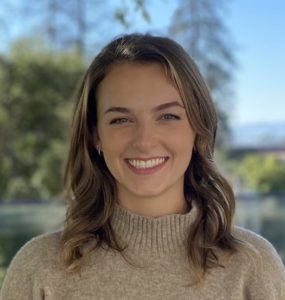
Startup Spotlight profiles startups founded by current Berkeley Haas students or recent alumni.
HOPO Therapeutics is a Berkeley-based biotech startup working to develop treatments for people exposed to toxic heavy metals in their homes, environments, and during medical procedures and treatments.
Hannah Weber, MBA/MPH 23, met HOPO co-founders Julian Rees and Rebecca Abergel—both scientists at the Lawrence Berkeley National Laboratory and leading experts in heavy metal poisoning–last year at a meet and greet hosted by the Berkeley Life Sciences Entrepreneurship Center.
The meeting was fortuitous. Weber came to Haas with a mission to work on developing a product or drug that could improve global health and to create a new model for access to medicine. Rees and Abergel told her that they’d been working on a drug to address lead poisoning and radiological hazards and were ready to find a partner to help raise funds and bring the drug to market. The meeting led Weber to join their team as vice president of strategy and business development.
A leap forward
More than 800 million children—about one third of the world’s young population—are currently living with lead poisoning, according to a UNICEF report. Other reports suggest half the current American population was exposed to harmful levels of lead in early childhood.
HOPO Therapeutics’ first product— HOPO-101—is a novel oral treatment that works by selectively binding to toxic metals so they can be removed from the body, a leap forward from older-generation treatments that also remove essential minerals in the process, Weber said.
The company expects the Phase 1 clinical trial to begin later this year, testing for the treatment’s safety in humans. “This innovative product has a broad application for hundreds of millions of people around the world suffering from heavy metal poisoning, and needs to be launched in a way that maximizes its application for public health,” said Weber.
“This innovative product has a broad application for hundreds of millions of people around the world suffering from heavy metal poisoning.”
HOPO-101 has received government funding to date, but one of Weber’s first goals for the company is to secure venture backing, starting with the company’s first seed round. Over the next five years, the company plans to develop relationships with physicians, governments, impact investors, and global health nonprofits to establish distribution channels.
“This is a lesson in sticking true to our values and finding partners that share our global health mission, and are eager to help us make it happen,” she said.
Weber pointed out that the pandemic has increased awareness of the importance of private and public partnerships in global health—her original mission for coming to Berkeley Haas.
“It’s made us all aware of the need for quick development and quick distribution of affordable life-saving drugs,” she said. “It’s also made the world appreciate the importance of public and private partnerships and the importance of collaboration across the table.”
Working on the company while at Haas also has its benefits, she said. “There are so many classes that allow you to explore your own venture within the classroom,” Weber said, noting that Health Management professional faculty members Kim MacPherson and Jeffrey Ford have been particularly helpful mentors. Weber has also found many opportunities to tap into the Bay Area startup ecosystem to advance the company, participating in the National Science Foundation’s I-Corps program for entrepreneurs, as well as the San Francisco B-School Disrupt showcase.
A passion for improving access
Weber, whose father was a physician, has been around healthcare her entire life and said she’s always had a passion for treating patients who had little access to care. Though she entered the undergraduate program at Georgetown University on a pre-med track, she quickly pivoted to global health and, more specifically, sought to focus her career on addressing how the pharmaceutical sector could be a partner in improved access.
An internship in Tanzania during college working on introducing digital innovations into government hospitals also led her to consider the impact a private company could have on global health. That led her to L.E.K. Consulting after graduating, where she worked in the Life Sciences Practice for nearly four years. Learning about strategy and market access from the point of view of pharmaceutical companies, made her look forward to being involved in making some of those company-forming decisions.
“I was excited at the prospect of working with a team developing novel medicines and asking big questions about how we could get them to people that needed them most,” Weber said. “I was looking to get involved with a small company launching a new technology, one that had that mission in mind.”
That mission led her to pursue an MBA/MPH at Haas, and has been the foundation for growing HOPO Therapeutics.
“I had a strong conviction that it was possible to do well and to do good. Business school has been an eye-opening chance to see how it’s possible,” she said. “Luckily, I’ve found a community at Haas and at HOPO that really resonates with that idea.”
Routine births are turning into moneymaking ‘emergency’ events at hospitals that work with private equity-backed staffing companies
FTC probes market power of one of country’s biggest anesthesia providers
Justin Chen Li: Making an impact in cancer diagnostics
Stereotypes about professional expertise contribute to the gender pay gap, study finds

When the Equal Pay Act passed into law almost 60 years ago, women working full time made 59 cents for every dollar earned by men. Since then, the gender earnings gap has narrowed but remains stubborn: A Pew Research Center analysis found that women earned 84 cents for every dollar that a male worker took home in 2020.
Common explanations offered for this disparity—which is present across most industries and professions, and is larger for minority women—include the perception that women are less likely than men to “lean in” and negotiate raises and promotions; women’s disproportionate childcare responsibilities; and stereotypes about women’s and men’s respective strengths and talents, which influence the industries they’re steered toward or from.
A new paper by Haas professors Mathijs de Vaan and Toby Stuart, published in American Sociological Review, highlights an underexplored way in which stereotyping can impact the livelihoods of women—particularly those working in high-skilled, client-based professions—long after they’ve committed to their industry of choice. The researchers reveal that gender stereotyping can weaken clients’ perceived trust in female professionals’ core offering: their expertise.
“All high-skill, client-based markets depend on trust, because the consumer is a non-expert relative to the provider,” says Stuart. “If you hire a banker, a mechanic, a management consultant, a financial advisor, or a physician and you don’t trust them, what do you do with the advice they give you? Do you follow it?” Most likely, he notes, you won’t follow the solution they’re recommending. Instead, you’ll seek a second opinion.
Gender and second opinions
Drawing from a rich dataset of medical claims information, Stuart and de Vaan examined whether physicians’ gender determined the perceived value of their expertise—as measured by how often patients sought second opinions.
They found that both men and women were more likely to opt for second opinions if the purveyor of the first opinion was a female specialist. However, male patients were much more likely than women to seek a second expert opinion.
The researchers also quantified the cost of this greater doubt in female physicians’ expertise, and discovered that on a per-patient basis, female specialists generated 10.7% lower billings than their male colleagues in the year following the average patient’s first visit.
“We think the results would be similar in professional settings with the same characteristics: where the client is uninformed relative to the service provider, and where there are gender stereotypes about professional competence, which definitely exist in finance, banking, management consulting, the legal profession, and many others,” Stuart says.
Patterns in placing trust
Stuart and de Vaan drew from an uncommonly comprehensive dataset: the Massachusetts All Payers Claims Database, which contains information about the medical claims of nearly every Massachusetts resident. The researchers zeroed in on data about first-time visits to medical specialists for new-to-the-patient health conditions between 2010 and 2015.
Digging into the data, the researchers unearthed several gender-related patterns in the relationships between specialists and their patients. First of all, the majority of patients preferred seeing specialists who shared their gender, including for first-opinion visits; across the board, patients were 22% more likely to see specialists of the same gender than those of the opposite gender.
The researchers also noted that after an appointment with a female specialist, both men and women were more inclined to obtain a second opinion from another specialist than they were if the first appointment was with a male physician. This likelihood was much stronger among male patients—perhaps because some women’s preference for the expertise of a male physician was partially offset by the desire to see a doctor of their own gender.
Male patients in particular tended to switch to male specialists for their second opinions—and since patients seeking second opinions most often stuck with the second specialists for any recommended medical services, what naturally followed were significant disparities in billings.
Male patients contributed disproportionately to the 10.7% shortfall in female physicians’ patient billings. The researchers observed that when a female specialist saw a male patient, her average one-year billing amount for him was 18% less than the average billing amount for a male colleague seeing a male specialist. This difference was only 7% for female patients.
Shifting perceptions, then reality
Stuart says he hopes awareness about these stereotypes might start to lead to shifts in both perceptions and reality. For his part, Stuart found the patterns revealed by his research striking enough that he’s shifted his own behavior.
“I categorically refuse a male specialist now that I’m aware of this,” he says, explaining that it’s one way to provide his own counterweight, however miniscule, to the pervasive perceptions that over time create very real outcomes.
“We hold all of these gendered beliefs about work even if we are not aware of them, and they have a way of becoming reality.”
Read the full paper:
Gender in the Markets for Expertise
By Mathijs de Vaan and Toby Stuart
American Sociological Review
Big Shot
Using Trump’s endorsement to boost vaccinations

While health officials have struggled to boost COVID-19 vaccination rates nationwide, a simple approach has proven effective at convincing some skeptics to get their shots: a video compiled from Fox News clips of former President Trump and his family urging his supporters to get vaccinated.
Researchers from Berkeley Haas, Stanford University, University of North Carolina at Chapel Hill, and North Carolina State University compiled a public service announcement from existing footage and aired it on more than 150,000 YouTube channels in more than 1,000 U.S. counties with vaccination rates below 50%. Compared with similar counties where the ad wasn’t shown, those counties recorded an additional 104,036 vaccinations.
While the researchers had no control over which channels the ad would appear on, the Google Ads’ algorithms sent it most often to Fox News’ YouTube channels, where it was attached to segments hosted by Laura Ingraham, Tucker Carlson, Sean Hannity, and other Trump supporters and vaccine skeptics. It also appeared on some neutral channels and some not supportive of Trump, including MSNBC and NBC News.
According to Professor Steven Tadelis, a co-author, the messaging was also relatively inexpensive. “Creating an intervention that effectively costs about $1 per extra vaccine is remarkably cost-effective and a small fraction of the cost of other interventions,” he says, noting that studies of U.S. state vaccine lotteries put the cost at $68 to $82 per vaccine.
However, while the ads moved some skeptics to action, they were only effective in counties with up to 70% Trump voters. The heaviest pro-Trump counties were unmoved.
YouTube channels where ads were placed

Percent of unvaccinated Republicans expressing a “great deal of confidence” in vaccine advice from specific sources
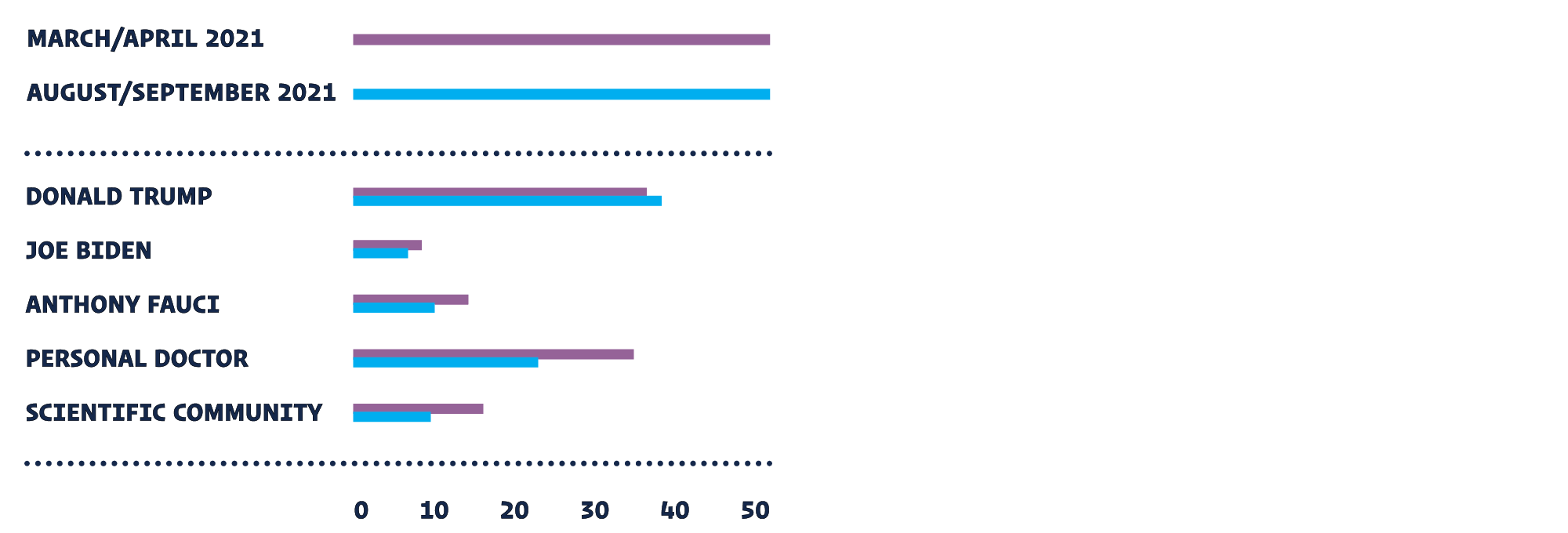
Geographic distribution of advertising campaign by county
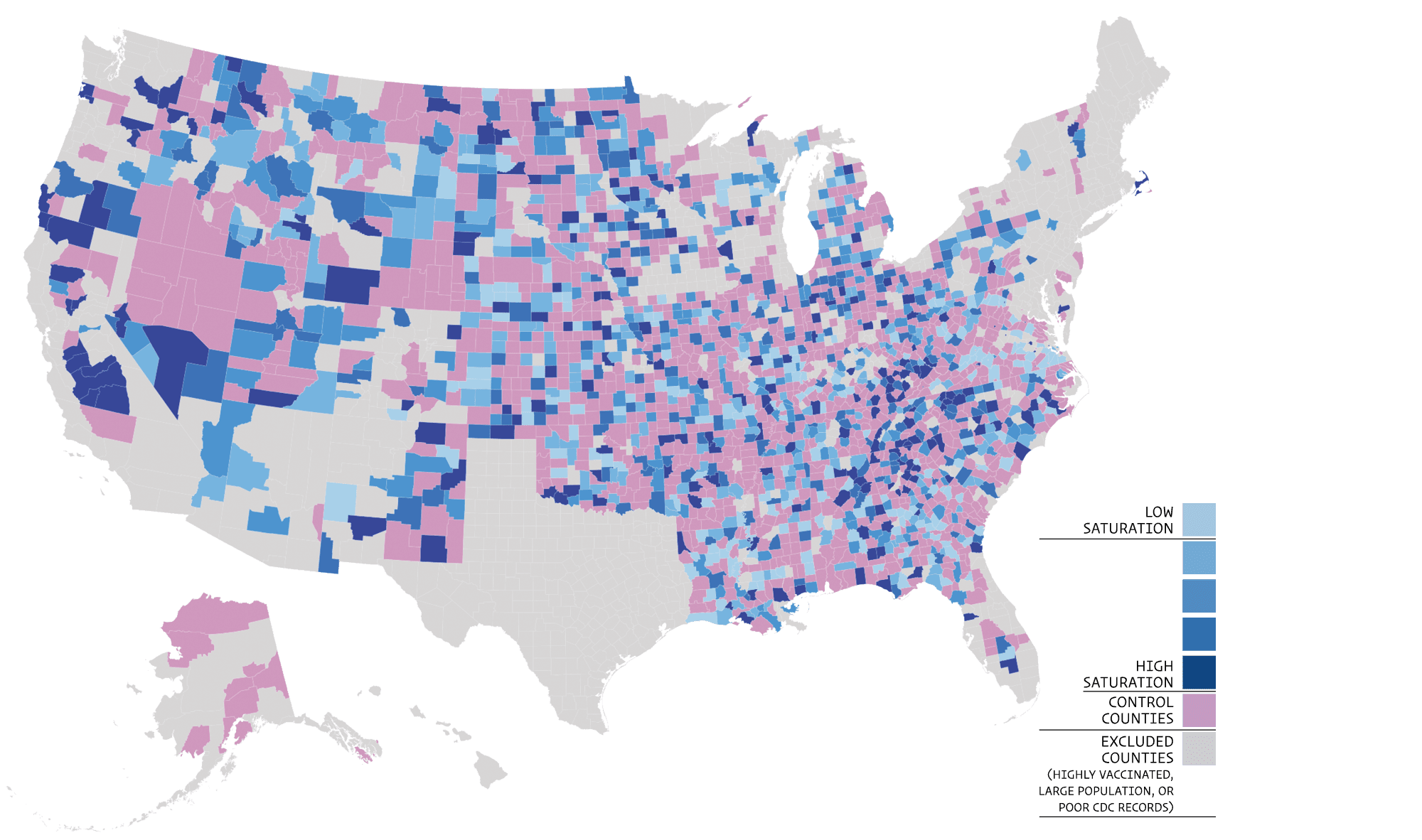
Berkeley Haas welcomes nine new professors
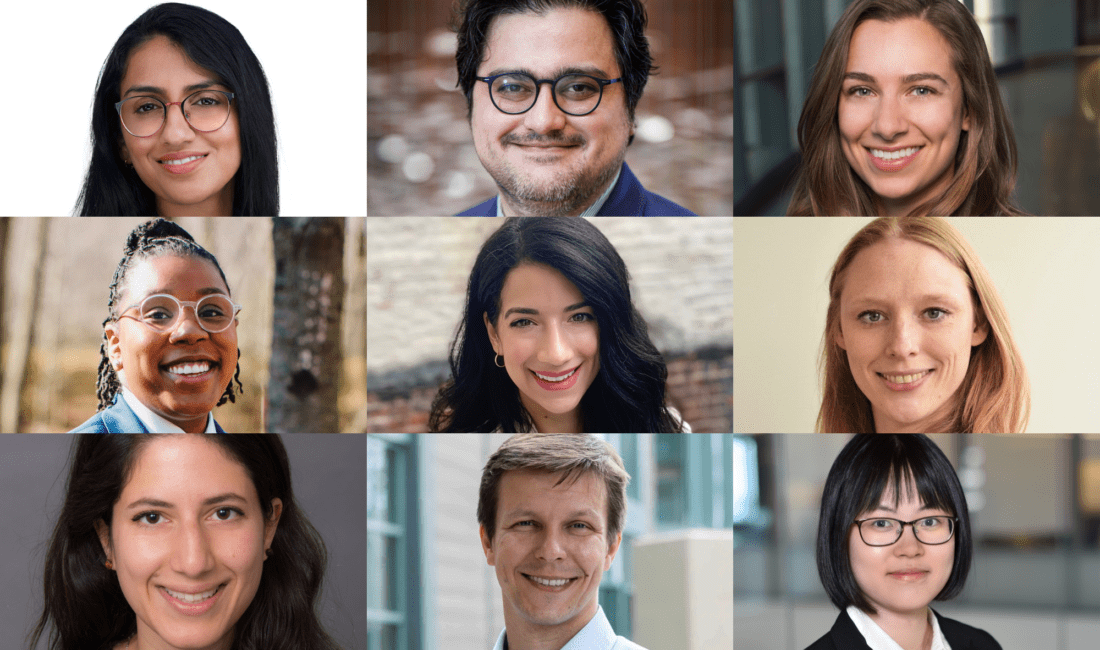
Nine new assistant professors have joined the Haas School of Business faculty this year, with cutting-edge research interests that range from illicit supply chains to unequal social hierarchies; from financial crises to the incentives that shape innovation; and from health care management to decentralized finance to marketing and the demand for firearms.
The nine tenure-track hires are the result of a concerted effort by Dean Ann E. Harrison and other Haas leaders to expand and diversify the faculty.
“We are thrilled to welcome this wonderful, diverse new group of academic superstars to Berkeley Haas,” says Dean Ann E. Harrison. “We clearly are bringing the best to Haas, increasing the depth and breadth of our world-renowned faculty, and reinforcing our place among the world’s best business schools.”
The new faculty members have hometowns throughout the U.S. and around the world, including Texas, New York, Massachusetts, and Illinois; Iran, the Dominican Republic, China, and the Netherlands. Seven of them are women; one is Black, and one is Latinx.
“This is our most diverse cohort of new faculty ever, each one a rock star in their own right,” says Jennifer Chatman, Associate Dean for Academic Affairs and the Paul J. Cortese Distinguished Professor of Management. “We are very proud that we were able to lure them to Berkeley Haas.”
The new faculty members start on July 1, with most beginning to teach in spring 2023. They bring the total size of the ladder faculty to 88, up from 78 in 2020-2021.
Meet the faculty
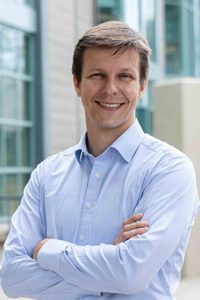
Assistant Professor Matthew Backus, Economic Analysis & Policy
(he/him)
Hometown: Chicago, Ill.
Education:
PhD, Economics, University of Michigan, Ann Arbor
MA, Economics, University of Toronto
BA, Economics and Philosophy, American University
Research focus: Industrial organization
Introduction: I’m an economist with broad interests. Most recently, I’m interested in how we can use the tools developed by the industrial organization community to understand inequality and the distributional effects of policy.
Teaching: Microeconomics and Antitrust Economics (MBA)
Most excited about: After spending a year visiting, I’m most excited about the economics community at Berkeley.
Fun fact: I have a border collie, who is in training as a herding dog.
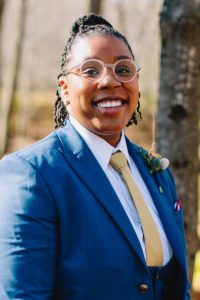
Assistant Professor Sa-kiera (Kiera) Tiarra Jolynn Hudson, Management of Organizations
(she/her)
Hometown: Albany, NY
Education:
PhD/MA, Social Psychology, Harvard University
BA, Psychology and Biology, Williams College
Research focus: I study the psychological processes involved in the formation, maintenance, and intersections of unequal social hierarchies, with a focus on empathic/spiteful emotions, stereotypes, and legitimizing myths.
Introduction: I am a social psychologist by training, focusing on the nature of intergroup relations as dominance and power hierarchies. I have studied several psychological processes, including the role of legitimizing myths in justifying unequal societal conditions, the role of group stereotypes in the experience and perception of prejudice, and the role of empathic and spiteful emotions in supporting intergroup harm. My work is multidisciplinary, incorporating quantitative as well as qualitative methods from various disciplines such as political science, sociology, and public policy.
I am a fierce advocate for building community, providing mentorship, and supporting authentic inclusion for everyone. I believe it is a moral imperative to be present as a vocal, queer-identified Black women in academe, given the lack of representation, and I’m excited to see how I can contribute to diversity, equity, and inclusion efforts at Haas.
Teaching: Core Diversity, Equity, and Inclusion (MBA)
Most excited about: I identify UC Berkeley as my intellectual birthplace. It was during a summer internship program through the psychology department in 2010 where I first became interested in studying power structures and intergroup relations simultaneously. My overall research interests haven’t changed since that fateful summer. Being a faculty member here is truly a dream come true!
Fun fact: I love organizing and planning, so much so I taught myself how to use Adobe InDesign to create my own planner. I am also an avid foodie and cannot wait to check out the Bay’s food and wine scenes.
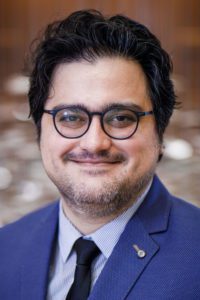
Assistant Professor Ali Kakhbod, Finance
(he/him)
Hometown: Isfahan, Iran
Education:
PhD, Economics, MIT
PhD, Electrical Engineering & Computer Science (EECS), University of Michigan
Research focus: Information frictions; liquidity; market microstructure; big data; and contracts
Introduction: I am a financial economist with research interests in financial intermediation, liquidity, contracts, big (alternative) data, banking and financial crises. A common theme of my research agenda is to study various informational settings and their financial and economic implications. For example: When does securitization lead to a financial crisis? Why is there heterogeneity in the means of providing advice in corporate governance? How does information disclosure in OTC (over-the-count) markets affect market efficiency? My research has both theory and empirical components with policy implications.
Teaching: Deep Learning in Finance (MFE)
Most excited about: Berkeley Haas is the heart of what’s next with world-class faculty working on exciting and innovative research. Given that my interdisciplinary research interests span finance, economics and big data issues, I could not ask for a better fit.
Fun fact: In my free time, I like to ski, sail, hike, and enjoy the outdoors.
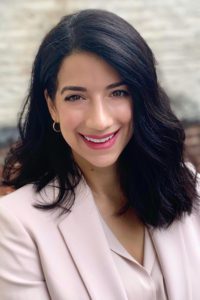
Assistant Professor Ambar La Forgia, Management of Organizations
(she/her)
Hometown: I was born in Santo Domingo, Dominican Republic, but I grew up in Washington, DC and São Paulo, Brazil.
Education:
PhD, Applied Economics and Managerial Science, The Wharton School, University of Pennsylvania
BA, Economics and Mathematics, Swarthmore College
Research focus: Health care management; mergers and acquisitions; firm performance
Introduction: My research studies the relationship between organizational and managerial strategies and performance outcomes in the health care sector. In particular, I use quantitative methods to study how the strategic decisions of corporations to merge, acquire, or partner with other organizations can change managerial processes in ways that impact both financial and clinical performance. A secondary research strand studies how health care organizations adapt their service delivery and prices following changes in state and federal legislation.
Before joining UC Berkeley, I was an assistant professor of health policy and management at Columbia University’s Mailman School of Public Health. I am excited to continue to explore issues of healthcare quality, equity, and cost, while digging deeper into the management practices and organizational structures that could influence these outcomes.
Teaching: Leading People (EWMBA)
Most excited about: It is an honor to join the world-class faculty at Haas, and I am so excited to learn from and collaborate with my MORs colleagues on both the macro and micro side. Since my research is interdisciplinary, I also look forward to connecting with scholars in the School of Public Health.
As a self-proclaimed “city girl,” I am excited to get out of my comfort zone and explore the natural beauty of Northern California.
Fun fact: My hobbies include yoga, urban gardening, adopting animals and stand-up comedy.
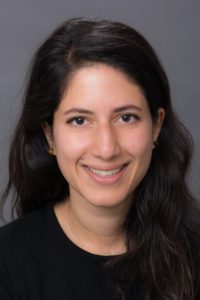
Assistant Professor Sarah Moshary, Marketing
(she/her)
Hometown: New York City, NY
Education:
Phd, Economics, MIT
AB, Economics, Harvard College
Research focus: Marketing and industrial organization
Introduction: My research interests span quantitative marketing, industrial organization, and political economy. I am currently working on projects related to paid search advertising, the pink tax (price gap in products targeted to women), and the demand for firearms. Before joining Haas, I worked at the University of Chicago Booth School of Business and at the University of Pennsylvania.
Teaching: Pricing (MBA)
Most excited about: I am excited to get to know my future colleagues!
Fun fact: My two hobbies are running and pottery—though I am more enthusiastic than talented at either :).

Assistant Professor Tanya Paul, Accounting
(she/her)
Hometown: Murphy, Texas
Education:
PhD, Accounting, The Wharton School, University of Pennsylvania
BS, Economics, Statistics and Finance, The Wharton School, University of Pennsylvania
Research focus: Standard-setting and financial reporting; the determinants and consequences of voluntary disclosures
Introduction: After getting my PhD, I spent a year at the Financial Accounting Standards Board learning about contemporary accounting issues and understanding the types of questions that standard setters are grappling with. I hope to continue working on research that is helpful to standard setters in coming up with standards that ultimately improve financial reporting.
Teaching: Corporate Financial Reporting (MBA)
Most excited about: I love how interconnected the area groups are within Haas. There are so many potential learning opportunities, especially for a newly minted researcher like me.
Fun fact: In my free time, I love to read and play the piano—I had learned it as a child and am trying to relearn it now as an adult.
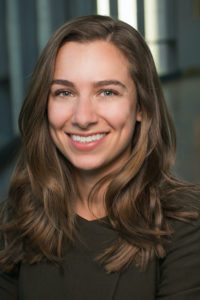
Assistant Professor Carolyn Stein, Economic Analysis & Policy
(she/her)
Hometown: Lexington, Mass.
Education:
PhD, Economics, MIT
AB, Applied Mathematics and Economics, Harvard College
Research focus: Economics of science, innovation, and applied microeconomics
Introduction: I study the economics of science and innovation. My research combines data and economic theory to understand the incentives that scientists face and decisions that they make, and how this in turn shapes the production of new knowledge.
One thing I love about economics is that it’s less of a narrow subject area, and more a set of tools and principles that apply to a stunningly wide array of topics. I’m excited to work with Haas students to help them understand how economic principles can improve their decision-making, both in their careers and in other areas of their lives—maybe even in ways that surprise them!
Teaching: Microeconomics (EWMBA)
Most excited about: I’m excited to be part of a large and superb applied microeconomics community—at Haas, and more broadly at Berkeley as a whole.
Fun fact: I am an avid cyclist and skier, and I was on the cycling team at MIT. Since moving to the Bay Area, I’ve loved the hills and mountains in the area. I’m working on taking my riding off road (gravel and mountain biking) and skiing off-piste (backcountry).
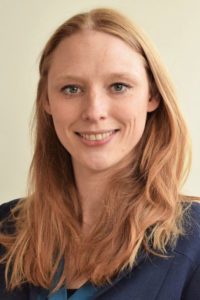
Assistant Professor Sytkse Wijnsma, Operations and IT Management
(she/her)
Hometown: Amsterdam, the Netherlands
Education:
PhD, Management Science and Operations, Judge Business School, University of Cambridge
MPhil, Management Science and Operations, Judge Business School, University of Cambridge
BSc & MSc, Economics and Finance, VU University, Amsterdam
Research focus: My primary research interest is designing supply chain and policy interventions that help solve real-world challenges with social and environmental impact.
Introduction: I am very excited about my projects on illicit supply chains and how they undermine social and environmental goals. The context of these projects spans a wide range of areas, from illicit waste management to illegal deforestation. I am also excited to deepen and expand ongoing research collaborations with governments and industry to investigate these issues.
Teaching: Sustainability in Business (Undergraduate)
Most excited about: Many things! Berkeley Haas, being at the forefront of sustainability, has a unique position that combines the same ideals that drive my research with opportunities for collaborative research with serious impact. The amazing colleagues and close connections to industry make it even more exciting to join this community!
Fun fact: My first and last name originate from Fryslân, a northern province in the Netherlands, where it is still tradition to name your children after family members. So although my name is quite rare in the rest of the world, in our family it crops up in every generation!

Assistant Professor Valerie Zhang, Accounting
(she/her)
Hometown: Shanghai, China
Education:
PhD, Northwestern Kellogg School of Management
MA, Economics, University of Toronto
BCom, Finance and Economics, University of Toronto
Research focus: Information dissemination; information cascades on social media; retail investor behavior; decentralized finance
Introduction: I am passionate about doing research or working on personal projects that can express my creativity. I enjoy merging disjointed ideas and working on interdisciplinary research. My dissertation combines two literatures: one in computer science on information cascades on social media, and another in finance and accounting on the effects of disseminating financial news. I am also very curious about emerging technologies that are reshaping the financial industry. Since I work on areas that are new to the research community, I sometimes feel like a lone traveler exploring completely new territories. It is terrifying but also extremely rewarding!
Teaching: Financial Accounting (Undergraduate)
Most excited about: I look forward to inspiring my students to be entrepreneurial and to come up with creative business ideas or projects.
Fun fact/hobby: I write short stories. The one I am working on has an alien and a squirrel in it.